According to the textbooks, the Dinosaurs were killed off by climate change caused by a large meteor that crashed into the gulf of Mexico. Whilst simple and apparently obvious – it fails in several respects: dinosaurs were already dying out before the meteor and some continued after the meteor and therefore if the meteor were the “cause” and not just a coincidental event we would still expect to see dinosaurs**. Also, it’s difficult to explain how every single dinosaur died – because even if it were winter for several years – if just two dinosaurs survive, then they would soon repopulate the world and descendant species would still be with us today but they are not**.
What did kill the dinosaurs?
I wish to propose a simple theory: it was “rabbits that killed them” – and no! I’m not mad, nor is this April 1st – instead this is a serious proposal … although when I say “rabbit” I am being humorous as I really mean small furry creatures like our modern rabbits that eat grass (but as I don’t know what they should be called – I will call them “rabbits”. However, … referring to “killer rabbits” … does allow me to show this Monty Python video film near Loch tay at an early industrial site where they mined copper ore.
Back to the theory
The theory is in essence very simple. Dinosaurs were big, because the plant eater ate big plants (like tree ferns below). As a result the dinosaurs* needed peg like teeth designed for tree ferns as shown below.
As this specimen demonstrates, the tree fern has a canopy of leaves growing on top of a hard trunk (much like a real tree). And for obvious reasons, the ferns would try to grow bigger than all the animals that could eat them, and once they towered above every living creature they very much dominated the landscape and could not be eaten.
Hence, the arms race of bigger and bigger tree ferns encouraging the evolution of bigger and bigger herbivores – and by inference – bigger and bigger carnivores. But in essence, the world of the dinosaurs was dominated by ferns, and dominated by animals developed to eat ferns – which according to the program “walking with dinosaurs” – meant they needed “peg like teeth” – which if I understood them correctly were used to grab the leaves and then stripped the finer more edible material from the coarse stems.
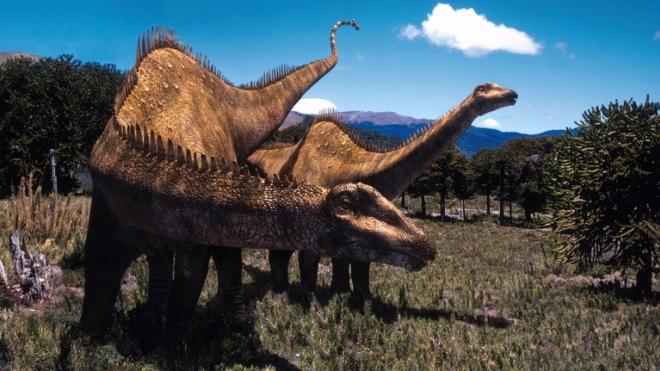
Scene from “Walking with dinosaurs” showing fabricated images of dinosaurs super imposed on a real BUT VERY RARE modern ecological niche where ferns dominate and grass is (mostly) absent.
Then along came grass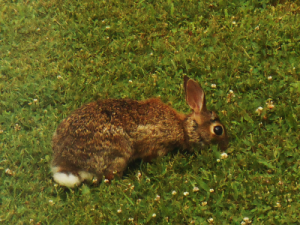
To the side is a rabbit – and perhaps more importantly but less noticeable as it is so common – is grass. It is now so common in our landscape we don’t even really notice it.
But, when I watched “walking with dinosaurs” and saw the commentary about filming the series, one thing that stuck out was the comment about how difficult it was to find modern landscapes because of one small problem: GRASS. Grass is now so prevalent it is nearly impossible to find locations without it – whereas at the time of the dinosaurs it was entirely missing. (allegedly)
But notice the grass above – for it is not just any grass , but grass cropped down to a very low level by teeth designed to “nibble” vegetation as opposed to the dinosaur. And notice what is not there – anything larger than grass. This is because the rabbits evolved to eat all plants down to the ground. Whether grass (which survives this as it grows from the root) or other plants like trees (which cannot tolerate this attack, because they grow from the tip of the bud) rabbits eat the lot. But only grass survives the attack.
And notice the effect of rabbits (and other nibbling animals like sheep) – whereas it might seem bad for the grass that it is eaten – the actual effect of the rabbits and sheep is to remove the competitors to grass like trees which would eventually out grow it. So – paradoxically the rabbits are doing the grass (and themselves) a favour by eating the grass (along with all its competitors).
If it isn’t obvious – dinosaurs with peg-like teeth simply could not survive on finely hewn down grass meadows like this because their teeth were not evolved to “nibble”. Rabbits however could not survive in fern forests (unless they were tree climbing rabbits).
So, how could rabbits possibly kill off the dinosaurs? The answer is simple: all fern forests have to start as seedlings at some time – and if these seedlings happen to be on the edge of a grass area grazed by rabbits – then the rabbits will kill them off and prevent regrowth.
So, pretty soon after the evolution of grass – and grass-eating/fern-seedling-killing animals like rabbits, the grassy areas will start to spread. Obviously no single rabbit would ever notice any difference – but the cumulative effect over many many many generations could be the total obliteration of fern forests and their replacement with grass prairies.
How the mighty fall
In other words, a world dominated by very tall fern-forests, and very large herbivores evolved to eat the leaves from the forests and very large carnivores evolved to eat the large herbivores – could be obliterated not by something massively big like a comet – but by something as small as grass.
It’s more complex
To make the argument simple I’ve presented the most obvious competition between big “peg” teeth dinosaurs evolved to eat ferns and small nibbling mammals (like our modern rabbit). However, not all dinosaurs had pegged teeth, but what is clear is that no dinosaur evolved to eat grass – that grass was not present at the time of the dinosaurs and that now in a mammal dominated world – dominated by grass eating mammals – grass is all prevailing.
A more complex theory is that small mammals evolved along side grass to create a “grass-ecosystem”. At first this would have been a very niche ecosystem perhaps tied down to a particular micro-climate (just as an example alpine, cold wind swept hills). As a result not only would there be specialist herbivores evolved specifically for this “grass ecosystem”, but there would also be carnivores.
A more complex theory is that these “ecosystems” competed with each other. That one dominated by mammals gradually became more and more successful pushing out of its original niche and then spreading. But the key to this competition would be the destruction of seedling ferns by herbivores (similar to our modern rabbit).
Man – the grass eater!
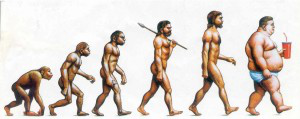 Finally (and particular as it annoyed my children so much when they were younger when I said it) – I would like to point out that we humans are in fact grass eaters. That is to say, our diet is still predominantly based on plants from the grass family: Wheat (bread, pastry, etc.), barley (beer & whisky), oats (porridge), rice. And when we don’t directly eat grass seed, we eat animals that eat grass (cows, sheep).
Finally (and particular as it annoyed my children so much when they were younger when I said it) – I would like to point out that we humans are in fact grass eaters. That is to say, our diet is still predominantly based on plants from the grass family: Wheat (bread, pastry, etc.), barley (beer & whisky), oats (porridge), rice. And when we don’t directly eat grass seed, we eat animals that eat grass (cows, sheep).
For more details see:
Moreover (according to prevailing thoughts) man evolved on the African grasslands. So, in some sense, humans owe almost our entire existence to grass. It therefore is not at all stretching the point to suggest that we modern humans owe our entire existence to grass. So, why is it so difficult to believe that grass and rabbit like mammals killed the dinosaurs?
One problem when did grass evolve?
The only problem for this theory is that (when I last looked a few years ago) the earliest evidence for evolution of grass is around 10million years after the end of the dinosaurs – however – as grass is so small it leaves very little evidence for its presence so this can only be pushed backwards and I’m pretty certain that sooner or later (like feathered dinosaurs) someone somewhere will find a sample show that grass started to appear just when the dinosaurs started to disappear.
The real impact of the meteor?
So far I’ve proposed that the new small mammal dominated grass ecosystem out competed the large dinosaur fern ecosystem. But what if anything was the impact of the meteor?
I tend to the view that grass ecosystem evolved in a small niche which by chance happened to be that which dominated when the meteorite fell. So, likely it was dark and presumably cold. This suggests an upland forest floor. There’s evidence dinosaurs were dying before the meteor – which would suggest that this new grass ecosystem was already starting to take over, so that when the meteorite hit, not only was it very suited (based on its origins) to cope with the climatic conditions that ensued, but that it was already fairly well spread so that it was poised to jump in.
So, perhaps the real effect of the meteorite was to accelerate the change that was already happening.
**for info technically birds are dinosaurs – or close dinosaurs – so technically we still have “dinosaurs”
*For simplicity at this point I suggest all dinosaurs have peg like teeth. This is not true – but it serves to make the argument. For a more complex suggestion see paragraph at end.

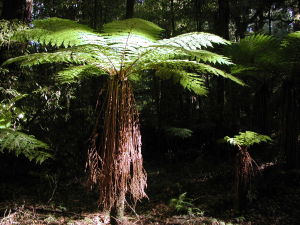
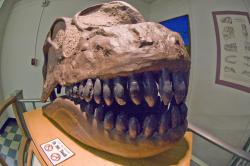

Hi Scottish Sceptic
as you predicted, here is a link putting back the appearance of grasses:
http://www.nature.com/nature/journal/v528/n7583/full/nature16441.html
sorry, my fault for using the word “grasses” – the article does not mention grasses, but talks about very small, transient flowering plants that could exploit temporary habitats and had excellent dormancy. Grasses would come later.
http://environment.yale.edu/news/article/study-preserved-embryos-illustrate-seed-dormancy-in-early-angiosperms/
still consistent with the killer rabbit idea ..